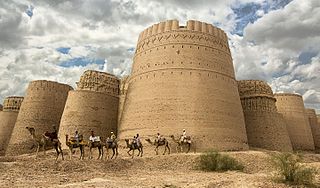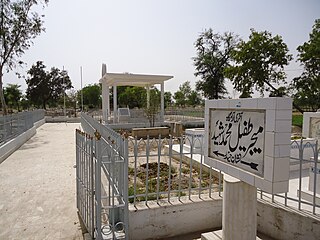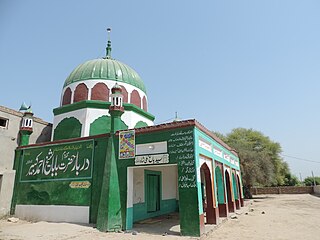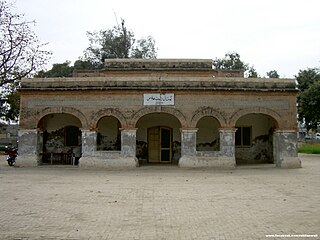
The Cholistan Desert, also locally known as Rohi, is a desert in the southern part of Punjab, Pakistan that forms part of the Greater Thar Desert, which extends to Sindh province and the Indian state of Rajasthan. It is one of two large deserts in Punjab, the other being the Thal Desert. The name is derived from the Turkic word chol, meaning "sands," and istan, a Persian suffix meaning "land of."

The Ravi River is a transboundary river crossing northwestern India and eastern Pakistan. It is one of five rivers associated with the Punjab region.

The Satluj River is the longest of the five rivers that flow through the historic crossroads region of Punjab in northern India and Pakistan. The Sutlej River is also known as Satadru. It is the easternmost tributary of the Indus River. The Bhakra Dam is built around the river Sutlej to provide irrigation and other facilities to the states of Punjab, Rajasthan and Haryana.

Bahawalpur District is a district of Punjab, Pakistan, with capital the city of Bahawalpur. According to the 1998 Census it had a population of 2,433,091, of which 27.01% were urban. Bahawalpur district covers 24,830 km2. Approximately two-thirds of the district (16,000 km2) is covered by the Cholistan Desert, which extends into the Thar Desert of India. The district is a major producer of cotton.

Vehari also spelled Vihari, is a city and the headquarters of Vehari District in the Punjab province of Pakistan. It is Pakistan's 62nd largest city. Vehari is about 100 km (62 mi) from the historical city of Multan. Vehari is located at the Multan-Delhi Road constructed by Emperor Sher Shah Suri. It is at an altitude of 135 m (443 ft).,{chak No 65.kb}

Vehari District is a district in the Punjab province of Pakistan. The city of Vehari is the capital of district while Burewala is the largest city and Jallah Jeem is the third largest city of the district.

Multan District, is a district in the province of Punjab, Pakistan. Its capital is the city of Multan. The district has a population of 4.75 million and an area of 3,720 square kilometres. The district consists of tehsils of Multan saddar, Multan city, Jalalpur Pirwala and Shujabad.

Lodhran District, is a district in the province of Punjab, Pakistan, with the city of Lodhran as its capital. Located on the northern side of the River Sutlej, it is bounded to the north by the districts of Multan, Khanewal and Vehari, to the south by Bahawalpur, to the east lie the districts of Vehari and Bahawalpur; while district Multan lies on the western side.
Montgomery District was an administrative district of the former Punjab Province of British India, in what is now Pakistan. Named after Sir Robert Montgomery, it lay in the Bari Doab, or the tract between the Sutlej and the Ravi rivers, extending also across the Ravi into the Rechna Doab, which lies between the Ravi and the Chenab. The administrative headquarters was the town of Montgomery, present-day Sahiwal. In 1967, the name of Montgomery District was changed to Sahiwal District.

The Islam Headworks, commonly known as Head Islam, is a headworks on the River Sutlej in Hasilpur Tehsil of the Punjab province of Pakistan. It is used for irrigation and flood control.

Mailsi is a city in southern Punjab, Pakistan. It is the headquarters of Jallah Jeem-Mailsi Tehsil, an administrative subdivision of Vehari District.Sutlej-Jeemi river flows in the East.

Mailsi, is a subdivision tehsil, of Vehari District, in the Punjab province of Pakistan. It is divided into two blocks which are further divided into 31 Union Councils. Two of these form the tehsil capital Mailsi.
Khairpur Tamewali is a city Under the Migrant Civilization-Haryani Protection Association(MCHPA) and the capital of Khairpur Tamewali Tehsil, Bahawalpur District, Near the Tehsil of Jallah Jeem in Punjab, Pakistan.
Sulemanki Headworks is a headworks on the River Sutlej in Sulemanki Village, near Depalpur City in Okara district of the Punjab province of Pakistan.

Rohilanwali, is a popular town of Muzaffargarh District in the Punjab province of Pakistan.

Chak 1/M Kot Qadir is a village located in Tehsil Mailsi, Vehari District of Punjab province, Pakistan. Kot Qadir is located 18 km aways from Mailsi Tehsil, an administrative subdivision of the district. It is located 915 kilometres (569 mi) away from Karachi, 346 kilometres (215 mi) away from Lahore, 258 kilometres (160 mi) away from Faisalabad, 84 kilometres (52 mi) away from Multan, 42 kilometres (26 mi) away from district capital Vehari. It is located at 29°48'1N 72°10'33E at an altitude of 126 m (416 ft).

Dokota is a small town located in Mailsi Tehsil in the Vehari District of Punjab, Pakistan.
Tibba Sultanpur is a town between Multan and Vehari, Pakistan. The original name of the town was Tibba Sunta Pur, the name of a Hindu. After Partition, Muslims started to change the names of towns and cities. The name of Tibba Sunta Pur was modified to Tibba Sultan Pur.
Sardarpur Jhandir is a town in Mailsi, Vehari District, Punjab, Pakistan. It is located at 29°46′24″N72°01′18″E and an altitude of 130 meters.
















